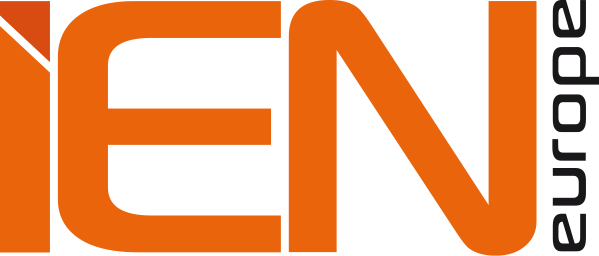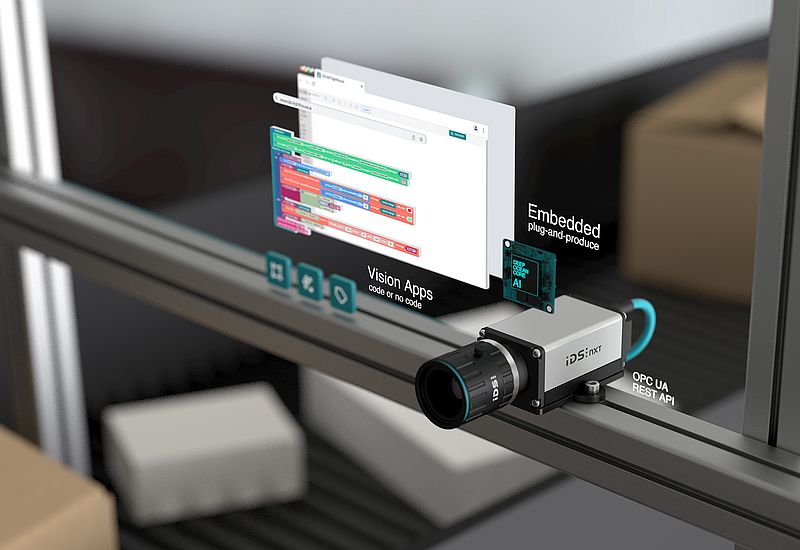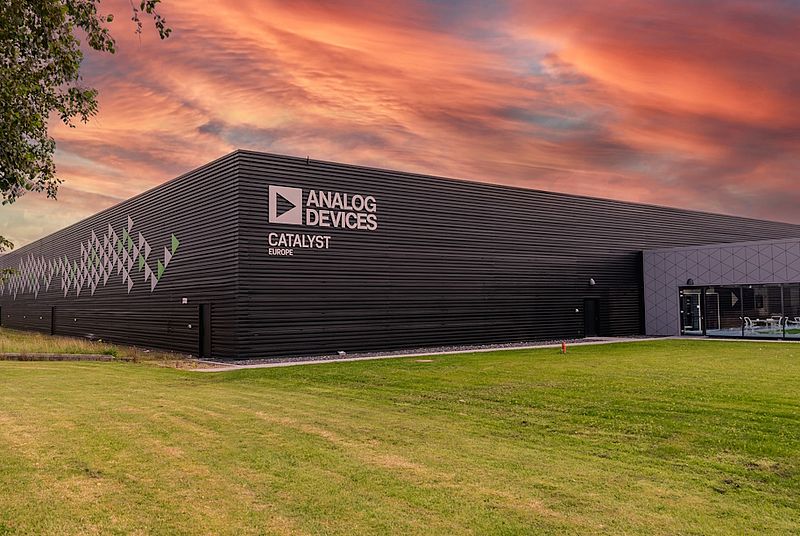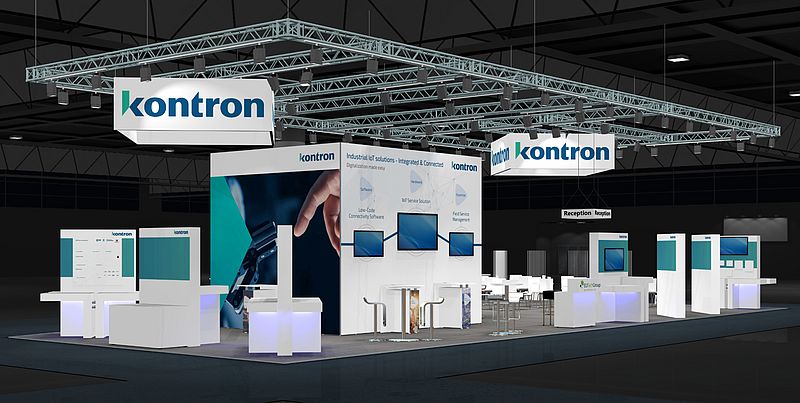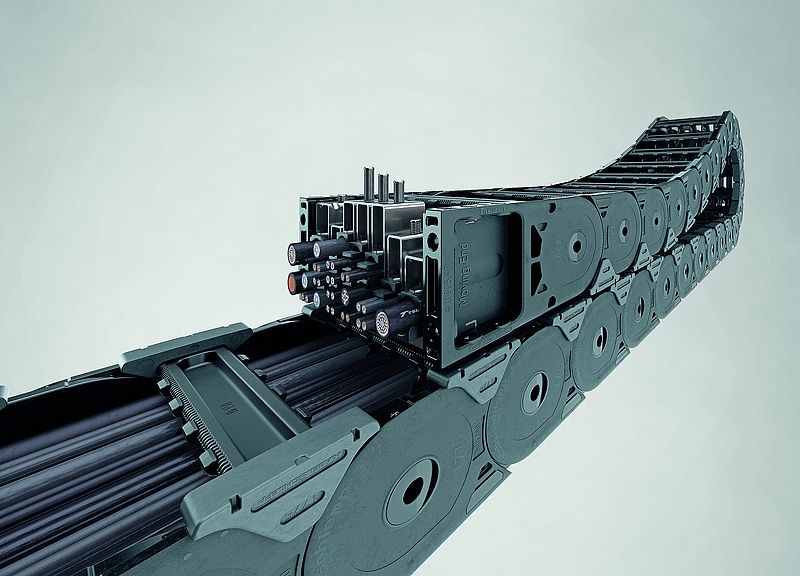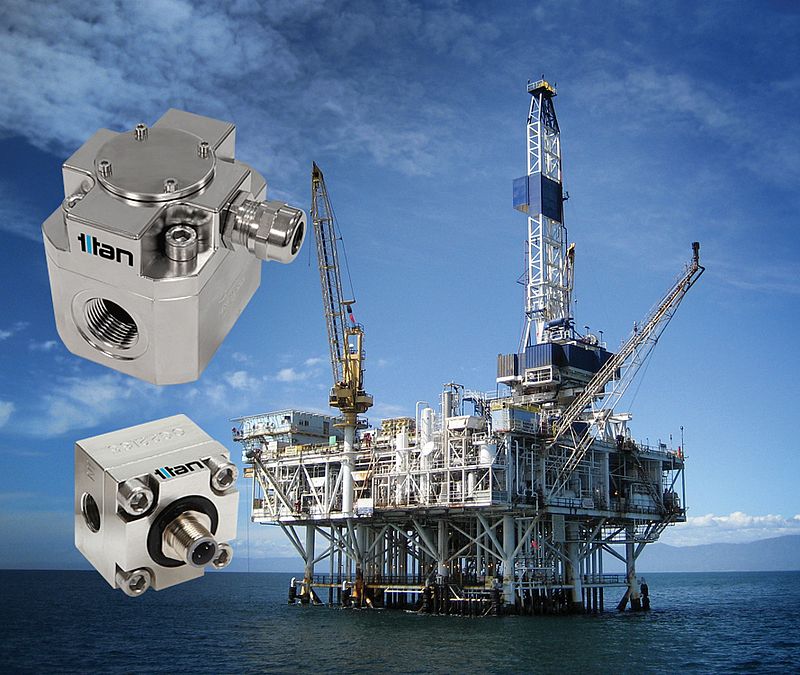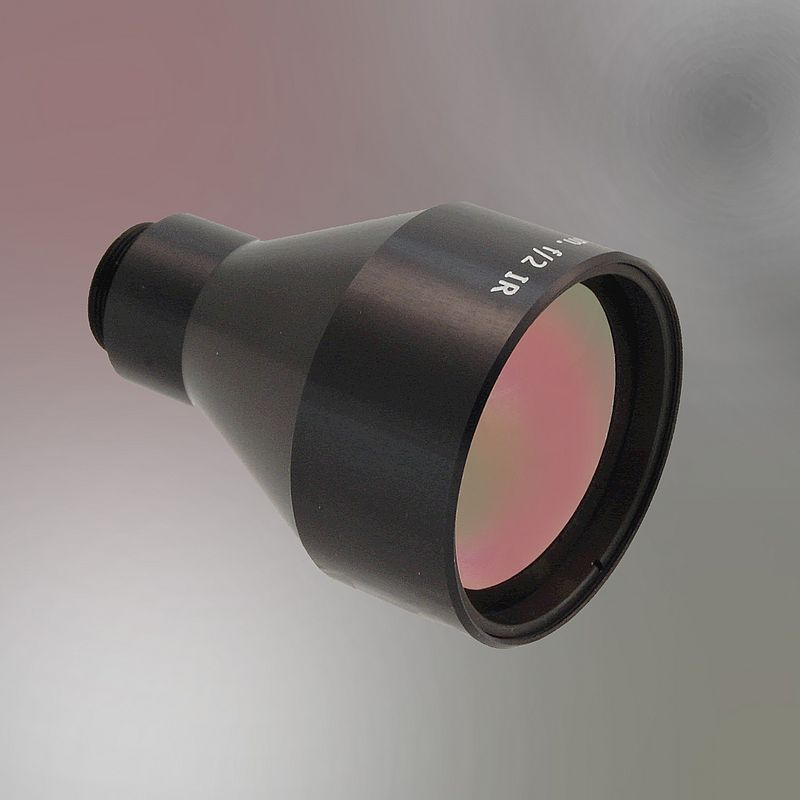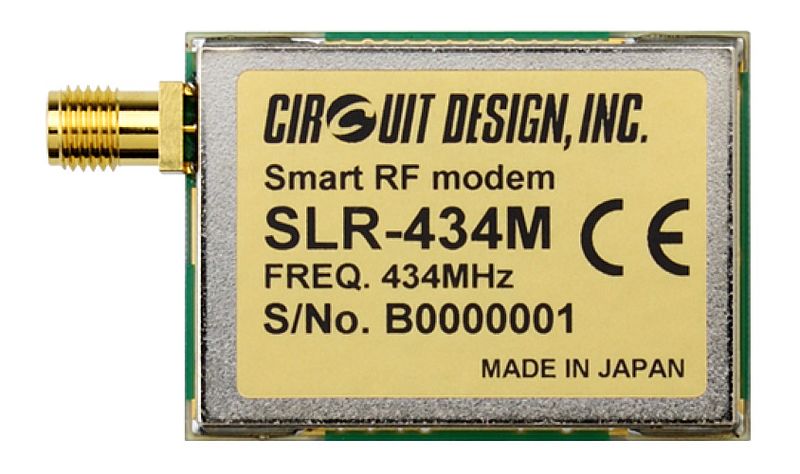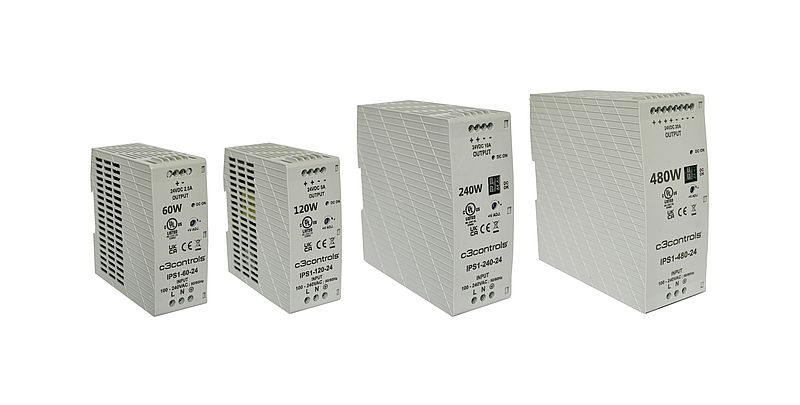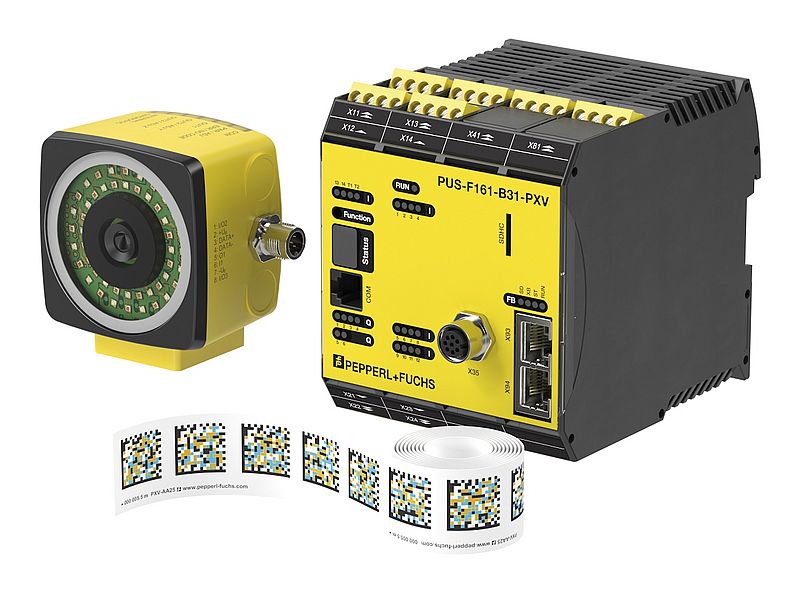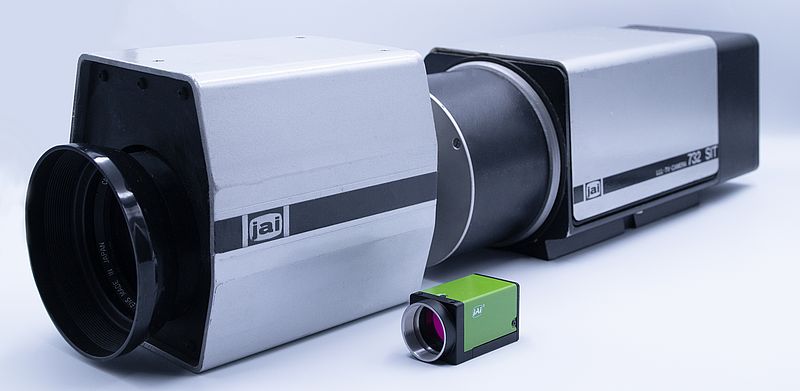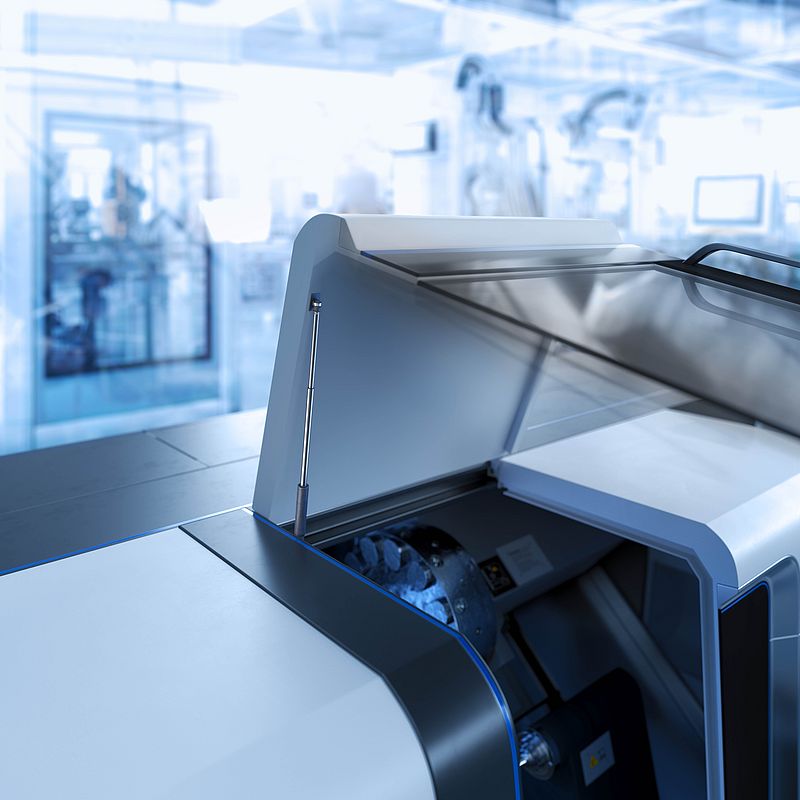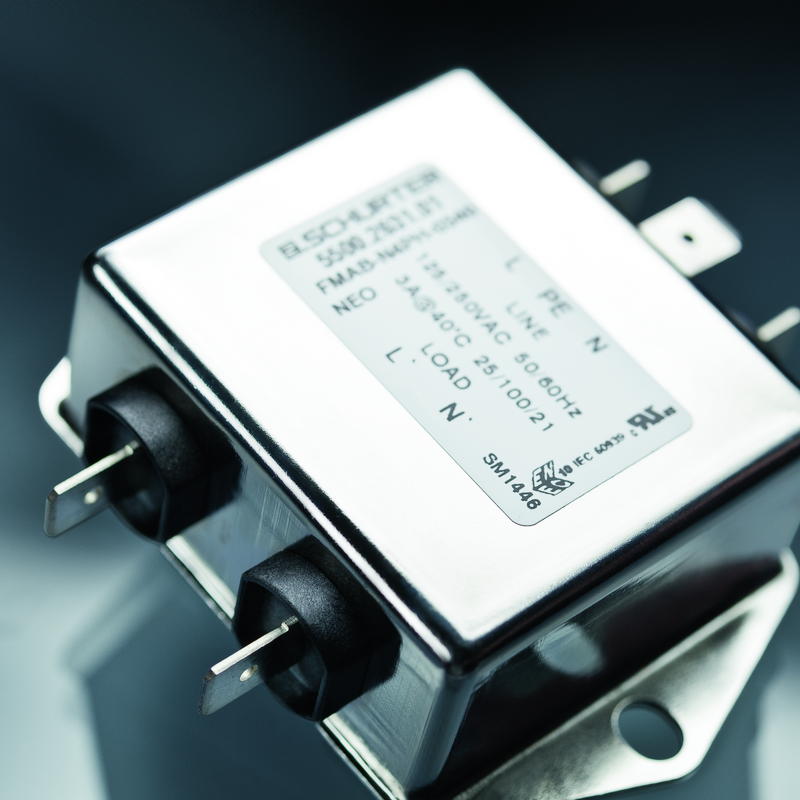Quick access
Emerson (Ad)5 Product Descriptions12 Stabilus (Ad)13 Product Descriptions14 Product Descriptions15 Product Descriptions16Companies in this issue
Circuit Design Inc.11 Portescap S.A.14 SCHURTER AG15 Skkynet Cloud Systems Inc.410 ABB Ltd3 Analog Devices GmbH7 Beckhoff Automation GmbH16 C3controls12 Circuit Design Inc.11 Emerson Industrial Automation5 IDS Imaging Development Systems GmbH6 Kontron Europe GmbH8 Microchip Technology10 Oriental Motor (Europa) GmbH11 Pepperl + Fuchs SE12 Portescap S.A.14 Resolve Optics Ltd9 SCHURTER AG15 Skkynet Cloud Systems Inc.4
Beyond Boundaries: Aspect-Driven Approach for Total Plant Efficiency
Integrating all plant data into a single, collaborative system
Plants and process control environments today feature a number of systems to ensure smooth and efficient operation. What if all the information within these disparate systems were integrated into a single holistic system regardless of their source? This is what ABB Ability System 800xA enables.
Organizing Information Beyond Files and Folders
Core to System 800xA is ABB’s Aspect Object Technology. This technology organizes information, not into files and folders, but into aspects of objects.
An object can be a physical object, like a valve, a complex entity, like a reactor, or an immaterial object, like a manufacturing order or production batch. All these objects have different information tied to them. These are known as aspects of the object.
One Click, Endless Insights: Streamlining User Experience
By bringing multiple libraries of object types and their aspects into one collaborative environment, users simply right-click an object to reveal information relevant to them.
The Aspect Object Technology within System 800xA enables enhanced collaboration and decision making, increased efficiencies, ease of scalability, and is therefore inherently more secure.
Getting More from OPC A&E
How to optimize OPC A&E data—collect it from multiple redundant networked sources, aggregate it in a unified namespace, and convert it to other protocols—to meet the demands of Industry 4.0
Industry 4.0
To get the most out of your OPC A&E data, you need secure, convenient and reliable access to it. This white paper explains how a good OPC A&E integration solution can provide networking, aggregation, redundancy, and conversion of the OPC A&E protocol itself.
Networking
OPC A&E uses DCOM for networking, which is difficult to configure and troubleshoot. Instead, tunnel/mirror software can connect OPC A&E clients and servers over a network, avoiding DCOM altogether. Done right, a tunnel/mirror system can make secure outbound connections from behind plant firewalls, keeping all inbound firewall ports closed, and also supporting connections through proxy servers and DMZs.
Protocol Conversion
A&E information is valuable in some systems that don’t support the A&E protocol, such as reporting packages and SCADA systems. Software that can do data conversions across a unified namespace can bring the value of alarm and event data to systems beyond the immediate context of an A&E client.
Aggregation
As demand grows for remote monitoring of alarms and events in complex systems, it helps to consolidate incoming OPC A&E data streams. Aggregating A&E data reduces network traffic and frees up bandwidth. Software that provides a unified namespace can collect A&E data from all sources and retransmit it to all connected clients.
Redundancy
Adding redundancy for A&E connections in mission-critical systems significantly improves the chances of alarms being received and acted upon. A redundancy broker monitors two identical connections and switches from one to the other whenever one data stream dops, allowing the client to continue uninterrupted.
Industry 4.0 is creating demand for plant data of all kinds. OPC A&E is often needed by analysts and upper management for large-scale planning and efficiency initiatives. This white paper explains how you can get the most out of OPC A&E data by aggregating it into a unified namespace and sending it across redundant networks to where it is most needed.
Detecting, Sorting, Counting – How AI Vision Can Be Integrated in Just a Few Steps
The processing of image data plays a crucial role in many industrial sectors, whether in quality assurance, production monitoring or robotics. AI-based systems open up many new possibilities and solve challenges that were previously difficult to overcome, even in existing industrial applications. This is because trained neural networks can recognize complex patterns, identify anomalies and even predict tool failures, leading to a significant improvement in process performance.
Vision & Identification
While the possibilities of AI-based image processing are fascinating, questions remain in many companies about how they can implement in their existing applications. How exactly the technology works and how to get it up and running in your own application still raises uncertainties and shows gaps in knowledge in numerous industries. Manufacturers of intelligent AI systems and cameras are providing answers by simplifying the use of AI-based embedded vision systems, among other things. IDS NXT is an example - this complete smart AI system opens the door to the effortless use of AI-based image processing not only for experts, but also for citizen developers. This makes integration into applications not only easier, but also quicker too.
Detecting, sorting, counting, verifying completeness
AI-based image processing has the ability to classify images into different categories - this is very helpful when it comes to detecting and classifying products. This makes it possible to automate many tasks that are still all too often done by humans. This includes identifying defects, sorting objects on conveyor belts and completeness checks. In particular, their ability to recognize complex patterns and structures in images makes them an important tool in quality assurance. This is because these are usually very difficult to detect with the human eye.
Feasibility studies for domain experts
Considering the many opportunities and challenges in the field of image processing, especially when using previously unknown technologies, tools and methods, carrying out feasibility studies is becoming increasingly important. On the one hand, they enable a reliable assessment of feasibility, but also carry the risk of quickly becoming complex and cost-intensive. However, the key skills for working with machine learning methods are no longer the same as for rule-based image processing. The quality of the results is no longer determined by the product of a manually developed program code by an image processing expert, but by the learning process with suitable sample data. Above all, this requires a deep understanding of the respective application.
What also reduces the effort, especially for initial application tests, is the fact that with a complete AI system such as IDS NXT, a large part of the development and evaluation process can be managed in a simple and intuitive cloud service. In this AI Vision Studio, users do not need to have any experience in AI, application programming or image processing. This benefits the very complex development of embedded systems in particular, which previously required special expertise with very specialized development tools. Under these circumstances, feasibility analyses can then be carried out solely by domain experts who have the most product knowledge. This means that companies are less reliant on programmers and image processing experts during the evaluation phase.
Short training cycles through the strategy of small steps
Once the initial findings from the feasibility analysis tests are available, adjustments can be made to the further procedure in order to increase the quality and performance of the AI models. It is important to note that a transition to larger data sets may be necessary. However, this should be a gradual process to ensure that models are trained correctly and robustly. A small data set at the beginning reduces the risk of overfitting, where the model "memorizes" the training data too much and generalizes poorly to new, unknown data. In addition, working with less data shortens the training phases and allows for faster experiments and iterations, allowing you to receive timely feedback and adapt the model or data sets accordingly.
User-friendly tools, such as those provided by the AI Vision Studio "IDS lighthouse" even for inexperienced users, also help to evaluate and evaluate training results with suitable sample data directly in the cloud. This means that you lose little time at the start of the project when experimenting due to time-consuming preparation and carrying out tests on the real machine, especially if several iterations are necessary.
Easy integration with All-in-One system
However, even if image processing can be generated intuitively with the help of user-friendly tools and even newcomers can achieve good results, its seamless integration into the customer application represents another significant challenge. This manifests itself in particular in the interfaces, both at hardware and software level. On the hardware side, this includes aspects such as connectors, cables, adapters and cable lengths to ensure a seamless connection. On the software side, integration revolves around issues relating to transmission protocols, result formats and the seamless integration of the image processing software into the system's control system. Software development kits (SDKs) often play a decisive role here, as they provide the necessary tools and resources to flexibly adapt the image processing functionality to existing system architectures. In order to master the variety of programming languages, developers are essential.
To ensure that image processing can be successfully and easily integrated not just as an isolated technology, but as an integral part of the entire application process, the hardware and software aspects of a user-friendly system must be considered from a holistic perspective. This is made possible by all-in-one embedded vision systems such as IDS NXT.
Intelligent image analysis in a building block system
The promise that AI-based image processing can be easily used by anyone, even without specialist knowledge of AI or application programming, only works if all components are designed simply and comprehensively, from image acquisition to the transmission of analysis results or the control of a machine. In addition to the intelligent camera hardware, IDS NXT also includes the AI data and training platform and enables individual analysis sequences to be plugged together via a block-based visual editor, which are then executed as apps on the camera at the touch of a button. With perfectly coordinated build tools, embedded vision development could hardly be easier. With standardized interfaces, such as digital inputs and outputs, a restful web service and industrial protocols such as OPC-UA, system integration of the complete system is as easy as with a smart sensor. Thanks to the app-based system, the analysis task can also be converted from one product to another within seconds. This minimizes costs for set-up times and makes specific embedded vision devices economically viable even for batch size 1. Simple and holistic access to AI-based methods, as with the example of IDS NXT, creates more acceptance for the new technology, which means that the knowledge gaps can finally be closed.
Author: Dipl.- Ing. (FH) Heiko Seitz, IDS Imaging Development Systems GmbH
Engineering the Future of Electronics
A trip to the ADI Catalyst™ in Limerick, Ireland, was one of the highlights of this year in the professional life of the TIMGlobal editorial team. You can find there not only one of the major fabrication sites for the worldwide semiconductor business, but also the ADI Catalyst™ – a collaboration hub “that builds ecosystems and resolves the toughest challenges”.
Electronics & Electricity
ADI's strategy has altered as it has developed over the past years and this collaboration hub shows how important the focus to strengthen collaborative partnerships with the customer has become. “The customers are taking ADI to the end user - to the consumer- to meet everyone’s needs” says Martin Cotter President of ADI EMEA.
With the Catalyst™ as an R&D environment and its test beds stretching about 100,000 square feet ADI is looking for cooperation and co-creation by creating a work environment where employees of the firm may interact with their counterparts from other clients' operations to achieve more fully formed solutions with ADI’s expertise.
A treasure of knowledge and innovation
ADI is currently the second-largest producer of patents in Ireland. According to Mike Morrissey, Director of the ADI Catalyst, there are about one thousand R&D engineers available in Ireland to work with. Developing engineering skills is an important objective for ADI’s Limerick operation. To guarantee the access to this genuine goldmine of talent and to support the student admission, it has partnered with the University of Limerick by establishing and funding an Immersive Software Engineering degree program. Students in this course can furthermore complete placements at the ADI Catalyst facility.
With this foresight and the company’s expertise in the different domains of analogue, digital, software, and AI algorithms the management of ADI Catalyst sees significant development potential in many key sectors.
Industrial innovation for industrial automation
ADI engineers collaborate on exciting projects for a range of industries with partners like Vodafone, Munich Electrification, Intel Corporation, Johnson & Johnson, Varjo, and Austrian Radio. These include better battery management for the next stages of e-mobility, sensors and communication technologies for the smart factory and Industrial IoT, and energy-efficient drives for automation technology.
The world of semiconductor is becoming critical for every industry
“The healthcare sector is asking for personalized solutions” says John O’Donnell, Director of Applied Technology Development at Johnson & Johnson Advanced Technology Centre. Making automated manufacturing lines more versatile is one of the problems that ADI and Johnson & Johnson, the pharmaceutical and healthcare brand, are attempting to solve at the Catalyst. The aging population requires more solutions and larger volumes, so the portfolio is growing. But access to talent is decreasing. This requires the use of automation. Today J&J has their own production line, but the trend is to be more dedicated, more flexible, more customer-oriented and more adaptable. They succeeded to improve handling high product mix requirements and make switching between different stock keeping units (SKU) easier.
Reducing the energy consumption of factories' old motor drives, creating incredibly detailed digital twins, fostering safer interactions between human coworkers and cobots, and reducing communication infrastructure latency to improve system responsiveness are additional areas of the industrial domain on which ADI research resources are being directed.
Collaboration on Electric Vehicles
Working with ADI at the Catalyst is the German company Munich Electrification. Their incentive is to optimize battery management system (BMS) efficacy regarding electric vehicle (EV) powertrains. ADI is the world's leading provider of BMS systems with more than 17 million systems shipped. Currently, 16 of the world's top 20 electric vehicle manufacturers use ADI BMS systems.
A big problem with electric vehicles is that the weight of their wiring harnesses is so great that it significantly reduces their range and therefore requires them to be charged more often. This increases the overall costs significantly and requires a lot of space in the vehicle. For this reason, the two companies have collaborated on an alternative BMS design that continuously and securely exchanges temperature, voltage and current data resulting in compact batteries and EVs with higher ranges.
This technology is not only interesting for the automotive industry, but also for energy storage systems.
“We need to design for the battery, and to bring more intelligence into the design of batteries. Data has become the heart of everything, but that data is moving back from the cloud, where it went 10 years ago, to the edge, to be available immediately.” suggests Shalini Palmer, Corporate Vice President at ADI EMEA.
The importance of innovation can be seen in mobile data traffic: improving technology has reduced energy consumption to less than 1%. Otherwise, data would consume up to 84% of the energy. In collaboration with Vodafone, ADI will deploy a private 5G network on the assets. The mobile network operator is working with ADI engineers to find ways to reduce power consumption of the radio access component of networks as the amount of data processed increases dramatically.
With the 5G network, cobot control, performance testing, and data collection from IIoT nodes will become easier.
The challenges of our time can only be solved together. We need collaboration accelerators like the Catalyst in Limerick: a co-creation space where the feeling of being able to work with and learn from each other in a familiar collaborative environment with the skills of ADI technologies to rapidly develop leading solutions which translates into more hope for our future.
Kontron at SPS 2023: Innovative Complete Solutions
Kontron has showcased integrated Industry 4.0 and IIoT solutions at SPS 2023. The main focus there was on the synergy between hardware, software and the supporting system consulting provided by Kontron as a comprehensive solution portfolio.
Kontron has showcased integrated Industry 4.0 and IIoT solutions at the Smart Production Solutions 2023 in Nuremberg from 14 to 16 November. The company shed light on the synergy between hardware, software and the supporting system consulting provided by Kontron as a comprehensive solution portfolio.
Experience IIoT through a live demonstration at the Kontron booth
This year Kontron has displayed an IIoT network in the form of innovatively networked computer systems. As an example, refrigerators are equipped with sensors to record and monitor key parameters in real time. System monitoring and data acquisition are carried out using secured Arm® and x86 systems with the KontronOS operating system in conjunction with the EquipmentCloud® digitalization solution. This allows easy monitoring of machine conditions, maintenance scheduling, software updates or remote access to machines. As an end-to-end solution, this live demonstration impressively illustrated the integration of hardware, software and competent system consulting offered by Kontron.
Update for the Kontron susietec® KontronOS and Connect IoT bundle
The Kontron susietec® toolset enables companies to implement holistic digitalisation solutions. With KontronOS, a secure industrial IoT-to-cloud operating system based on Linux® for networked systems is provided, which is available as standard on Arm® (AL i.MX8M Mini) and Intel® basis (KBox A-250). It provides protection against compromises and external access to the corporate network as well as uncontrolled updates. The automated update process ensures that the system is always up-to-date. Particularly with large device fleets, it makes sure that all devices in the field are at the same update level despite different schedules and threat scenarios.
Also on show at SPS was the new release of the Connect IoT bundle, which offers an extended range of versatile functions for machine manufacturers and operators. The bundle combines the powerful KBox A-250 industrial computer platform with the low-code interface integration solution FabEagle®Connect. The new version 3.1 integrates data interfaces to the SQL databases Firebird, Microsoft SQL, MySQL, Oracle, PostgreSQL as well as SQLite and simplifies the possibilities for edge data processing through C# code components. A filterable message monitor facilitates diagnosis during configuration and operation. From the end of 2023, the cost-optimised KBox A-250 will also be optionally delivered with pre-installed FabEagle®Connect to enable a quick start to network installations.
High-performance industrial PCs for Industrial IoT and AI
Kontron presented industrial computers in box PC format and as rackmount or workstation versions with powerful Intel® Core™ i processors of the 13th generation for computation-intensive applications as well as industrial-grade panel PCs and monitors for demanding control and visualization tasks. The product range for the Smart Factory is made complete by Smart technologies as well as scalable solutions and comprehensive services based on Time Sensitive Networking (TSN) and Artificial Intelligence (AI) for intelligent edge computing, convergent networks and workload consolidation.
Performant motherboards offering a high degree of scalability
The compact K3921-N mSTX motherboard, equipped with powerful Intel® Core™ i3 processors and Intel® N-series processors (Alder Lake N), is "Made in Germany" and impresses with outstanding performance in a handy mini-STX format. This versatile board supports up to three independent displays with 4K resolution and is ideal for use in industrial automation, medicine, digital signage, KIOSK, POS/POI and casino gaming. The matching SMARTCASE™ S501 is also available.
High-Performance Computer-on-Modules: Maximum flexibility for edge applications
Kontron offers the latest 13th generation Intel® Core™ Mobile processors on all COM Express® form factors and the high-performance COM-HPC® client modules. Particularly noteworthy here is the COM Express® mini series as an extremely robust and space-saving platform based on Intel® Core™ technology for the first time. An application-ready package consisting of a COM-HPC server module, board management controller and carrier board enables rapid implementation of the final solution. The right module can be selected for the requirements of the individual IIot application from the wide range of COMs in different performance levels and functionality.
Web Panels for industrial applications
Kontron will be expanding its HMI portfolio with a new web panel series based on Arm® NXP i.MX8M Plus processors. These panels are ideal for device and machine visualization as well as facility automation. They come in a range of display sizes (5'', 7", 10.1" and 15.6") and provide enhanced graphics performance, PoE capability and advanced connectivity. With the help of the integrated QIWI software toolkit, the configuration and parameterization of the device settings and browser properties are simplified significantly. The panels are ideally suited for use in industrial environments and ensure long-term availability as well as first-class technical support.
SPS 2023: Tsubaki Kabelschlepp to Present UNIFLEX Advanced 1775: the Standard for Many Applications
Tsubaki Kabelschlepp has presented cable carrier portfolio at SPS 2023. Among the exhibits is the popular UNIFLEX Advanced 1775 (UA1775) cable carrier.
The UNIFLEX Advanced 1775 (UA1775) cable carrier has been continuously expanded with new sizes and features in recent months. This qualifies the lightweight, quiet all-rounder for a wide range of applications, including in automotive production, gantries & axes, intralogistics, material flow and material handling, cranes and machine tool manufacturing, the timber industry, agricultural machinery and commercial vehicles.
The UA1775 is available with an inner height of 56 mm and in widths between 100 and 400 mm for the designs 020 (closed frame), 030 (with outside opening and detachable crossbars) and 040 (with inside opening and detachable crossbars). The durable cable carrier system impresses with its particularly quiet running and can be used with and without pretension and also unsupported and gliding on long travel lengths. High speeds and accelerations are also possible.
The four-part chain links are designed in such a way that the individual parts require only a minimum of storage volume, simplifying logistics and saving resources. With bending radii between 90 and 340 mm and the short pitch of 77.5 mm, the torsion-resistant design with its sturdy chain body ensures low wear. To protect the environment, TSUBAKI KABELSCHLEPP manufactures this cable carrier with up to 35 % regranulate.
In combination with the latest generation of the space-saving TS3 divider system, this opens up new areas of application, in particular in machine tool manufacturing and for gliding applications on gantries or axes. The TS3 system features a height separation with intermediate plastic partitions, while the narrow end divider on the outer sides ensures space-saving utilization of the space inside the cable carrier. The new divider is used for vertical division within the cable carrier as a standard. The complete divider system can be adjusted in the cross section and can also be used individually as a lockable TS0. The TS1 version with continuous height separation is another variant.
The UA1775 offers fast, easy and simple installation of cables and hoses: The crossbars can be opened and closed quickly – with just two steps in each case. A simple screwdriver is the only tool required. Particularly convenient: The crossbar remains attached to the chain link even when open and can therefore not be lost. If necessary, the crossbar can be released from the chain link with a simple twist.
With the easy-to-assemble design, the cable carrier offers great benefits especially as a ready-to-install TOTALTRAX® system or as an assembly for long travel lengths. In addition to high-flexibility cables, the TSUBAKI KABELSCHLEPP product range also includes guide channels made of aluminum and steel as well as drivers, roof system, condition monitoring components and much more.
Oval Gear Flow Meters for Metering High Pressure
Enable flow measurement of high viscosity liquids in demanding applications such as chemical and petrochemical industry.
Sensor Technology, Test & Measurement
Positive Displacement flow measurement devices, such as Titan Enterprises’ Oval Gear (OG) flowmeters, are one of the most widely used types of flow meter for measuring the flow of petroleum liquids and petrochemical additive injection fluids. They remain a solid choice for many applications in today’s modern process control environment, due to the OG’s suitability in harsh environments, high-pressure capability, and long-term reliability with minimum maintenance. They are also ideally suited for viscous fluids.
High viscosity liquids, such as fuels, thick oils, bitumen, resin and tar, require devices that are precision engineered to provide highly accurate flow measurement. The teeth in an oval gear meter are used to drive the gear and seal the central path, with the differential force being developed by the shape of the ovals rather than the gear teeth on the lobe. Oval Gears vary in size and shape depending on the resolution and flow requirement of the process application.
The pressure drop is essentially the limiting factor when it comes to metering high viscosity liquids within an application. The Oval Gears within these flow measurement devices provide a larger surface area generating a much greater driving pressure across the gears. This results in a wider flow range capability and lower pressure drop (see graph below) compared to other positive displacement meter types.
Neil Hannay, Titan Enterprises’ Senior Development Engineer, says: “The higher the viscosity of a liquid, the more pressure will be required to ‘force’ the liquid into the flowmeter and around the oval gears. It’s important to bear this in mind when selecting the correct size of oval gear flowmeter for your application. For example, more pressure will be required to push through resin than diesel.”
Metering high viscosity liquids
Almost immune from the effects of varying liquid viscosity, density and temperature, the measurement accuracy of Titans’ Oval Gear (OG) flowmeters improves as liquid viscosity increases, from a nominal 1% to around 0.1% of flow rate at higher viscosities. Titan’s standard OG models provide high accuracy up to 1000 cSt; for viscosities above 1000 cSt Titan’s specially profiled gears are supplied to facilitate additional flow of the liquid.
Titan Enterprises offer special options and adaptive designs of its Oval Gear meters to meet specific high-pressure requirements, aid chemical compatibility, and ensure safe operation in potentially explosive atmospheres. Titan’s Oval Gear range of meters include ATEX compliant IP65/NEMA 4 protection models, and devices that offer intrinsically safe options for processes that operate within harsh environmental conditions, such as explosive or corrosive atmospheres, where flowmeters are required to withstand tough environments whilst maintaining accurate and reliable measurement.
Titan’s Oval Gear meters can be pressure tested in-house up to 950 bar for custom-designed models and calibrated against diesel upon request. In the chemical industry, oval gear flowmeters are often used in conjunction with a batch controller to allow for the automatic dispensing of pre-set volumes of chemicals.
High Performance Thermal Imaging Custom IR Lens Assemblies
Engineered for use in thermal imaging, FT-IR spectroscopy, CO2 laser and defence applications.
Sensor Technology, Vision & Identification
Resolve Optics is a leading supplier of custom lens assemblies including high-performance Infrared (IR) optics for use in thermal imaging, FT-IR spectroscopy, CO2 laser and defence applications.
The company delivers thousands of custom lens assemblies per year – from complex high-speed imaging lenses, and material sorting inspection optics, to radiation resistant lenses for critical space and nuclear applications.
Optimising performance in the infrared waveband
Using substrates including germanium, sapphire, silicon or zinc selenide, Resolve Optics is experienced in developing and supplying IR lens assemblies with anti-reflection coatings to optimise performance in the infrared waveband to best suit your application.
Mark Pontin – Managing Director of Resolve Optics commented “While some optical design and manufacture companies promise low cost and high quality, few can match the innovative optical design and expert technical support that Resolve Optics is internationally renowned for. We have successfully developed many innovative and custom optical assemblies for our industry partners over the last 25+ years. We welcome the OEM design and manufacture opportunity to develop, design or manufacture special lenses and optical products”.
Machine Learning Development Suite for Easy Incorporation of ML into MCUs and MPUs
Unique solution is first to support 8-bit, 16-bit and 32-bit MCUs and 32-MPUs for ML at the edge
Artificial Intelligence
Machine Learning (ML) is becoming a standard requirement for embedded designers working to develop or improve a vast array of products. Meeting this need, Microchip Technology has launched a complete, integrated workflow for streamlined ML model development with its new MPLAB® Machine Learning Development Suite. This software toolkit can be utilized across Microchip’s portfolio of microcontrollers (MCUs) and microprocessors (MPUs) to add an ML inference quickly and efficiently.
“Machine Learning is the new normal for embedded controllers and utilizing it at the edge allows a product to be efficient, more secure and use less power than systems that rely on cloud communication for processing,” said Rodger Richey, VP of Microchip’s Development Systems business unit. “Microchip’s unique, integrated solution is designed for embedded engineers and is the first to support not just 32-bit MCUs and MPUs, but also 8- and 16-bit devices to enable efficient product development.”
ML uses a set of algorithmic methods to curate patterns from large data sets to enable decision making. It is typically faster, more easily updated and more accurate than manual processing. One example of how this tool will be utilized by Microchip customers is to enable predictive maintenance solutions to accurately forecast potential issues with equipment used in a variety of industrial, manufacturing, consumer and automotive applications.
Complete solution that can be easily implemented by those with little to no ML programming knowledge
The MPLAB Machine Learning Development Suite helps engineers build highly efficient, small-footprint ML models. Powered by AutoML, the toolkit eliminates many repetitive, tedious and time-consuming model-building tasks including extraction, training, validation and testing. It also provides model optimizations so the memory constraints of MCU and MPUs are respected.
When used in combination with the MPLAB X Integrated Development Environment (IDE), the new toolkit provides a complete solution that can be easily implemented by those with little to no ML programming knowledge, which can eliminate the cost of hiring data scientists. It is also sophisticated enough for more experienced ML designers to control.
Microchip also offers the option to bring a model from TensorFlow Lite and use it in any MPLAB Harmony v3 project, a fully integrated embedded software development framework that provides flexible and interoperable software modules to simplify the development of value-added features and reduce a product’s time to market. In addition, the VectorBlox™ Accelerator Software Development Kit (SDK) offers the most power-efficient Convolutional Neural Network (CNN)-based Artificial Intelligence/Machine Learning (AI/ML) inference with PolarFire® FPGAs. MPLAB Machine Learning Development Suite provides the tools necessary for designing and optimizing edge products running ML inference.
Elevate Your Communication in Harsh Environments
The SLR-434M is a compact embedded radio modem, operating in the 434MHz
Electronics & Electricity
Essential infrastructure such as irrigation canals, hydroelectric dams, rivers and agricultural farms always need to be monitored to ensure safe and efficient operation.
Currently to do this, there is monitoring technology that utilizes low-power radio. By using long-range wireless communication to monitor activity, it is possible to identify problems as soon as they occur.
The SLR-434M is a compact embedded radio modem, operating in the 434MHz (ISM band). It allows information to be transmitted over long distances in LoRa® mode (approximately 10 kilometers) or operate in conventional FSK mode.
By connecting to an external CPU or PC with UART interface, the user can send data or design simple control systems using Circuit Design's dedicated command protocol for industrial applications. It is also possible to process up to 8 switching signals.
High Performance with Low Energy Consumption
This is how the BLDC drives of the BMU Series excel
Motors & Drives
Oriental Motor's BMU Series includes compact, lightweight and powerful brushless DC motors that are efficient and environmentally friendly. They are available in rated capacities from 30 W to 300 W and use a permanent magnet in the rotor, which contributes to energy savings. Unlike induction motors, the speed remains constant, with an extended speed control range and constant torque.
BMU motors reach 80 - 4,000 rpm and are controlled by AC drivers. Synchronization of actual and command speed allows easy control by knob and display. The motors are dust protected, waterproof (IP66/IP67) and available with either spur or hollow shaft gearboxes. Cables can be routed to the shaft, to the rear or vertically. In addition, the integrated overload alarm warns if the motor exceeds the continuous operating range.
The BMU Series offers customizable solutions, optimizes energy consumption and ensures reliable performance.
Industrial Low Voltage Power Supplies
For equipment that requires control within electrical panels and enclosures
Electronics & Electricity
c3controls has launched a new line of Industrial Power Supplies that provide stable, low voltage power for equipment that requires control within electrical panels and enclosures. The new Series IPS power supplies deliver up to 93% efficiency, the best in its class among comparable devices, and are available in output power ranges from 60W to 480W and voltage options in 12, 24 and 48V. Ideal for regulating power loads in residential, commercial and industrial applications such as HVAC, manufacturing, industrial automation, and pump and motor control, the c3 power supplies are UL listed, CE marked, and RoHS compliant.
The ultra-compact Series IPS power supplies range in width from 43 to 60mm, and are designed to fit in panels of almost any size, with quick and simple snap-on installation on a 35mm DIN Rail. The control devices provide reliable protection against short circuit, overload, overvoltage and over-temperature occurrences, and feature an auto-recovery function. The output voltage of the devices is flexibly adjustable from 100 to 116%. The LED indication allows users to see the availability of the DC power output to assist in troubleshooting. The power supplies from 240W to 480W come with DC OK Relay Contacts to provide status signals to the monitoring system.
Safe Absolute Positioning System
Rugged Sensor Technology and Evaluation Unit for SIL 3 and PL e
Automation
Determining a safe absolute position usually requires using highly complex technology. Pepperl+Fuchs offers much simpler solutions for this process, which are based on a combination of the new PUS evaluation unit with the safePXV or WCS sensors. Safety functions (SF) complying with SIL 3 and PL e can therefore be achieved with minimal integration effort.
The safePXV noncontact absolute positioning system only requires one camera-supported sensor since it provides intrinsic redundancy through multicolored Data Matrix codes. For linear-guided applications such as monorail conveyors and automated storage and retrieval systems, it offers positioning with millimeter precision over tracks up to 10 kilometers in length.
Safe position and speed
The rugged WCS position encoding system for absolute positioning in outdoor areas uses a stainless steel code rail with recesses. In the safe version, two U-shaped read heads monitor this rail and ensure reliable detection along track distances of up to 314.5 meters, even in adverse conditions such as those found when operating port cranes.
The redundant signals from the sensors are processed and evaluated by the PUS-F161-B safe evaluation unit via two channels. The device acts as a gateway to the fieldbus. It generates a safe position value (SafePos SF), which it can also use to determine a safely monitored speed (SafeSpeed SF). Applications that integrate the sensors and the evaluation unit are certified according to IEC 61508 for SIL 3 and according to EN 13849 for PL e. They enable quick and easy commissioning through pre-certification and pre-configuration.
Motion Technology Integral to Devices for the Treatment of Cardiovascular Disease
From treatment of narrowed arteries to circulatory support, miniature motors are at the heart of medical devices used to treat cardiovascular disease. When selecting motor solutions for such applications, compact size and precision control are key factors.
Motors & Drives
Earlier this year, the World Heart Federation, the global organisation that focuses on cardiovascular disease prevention, reported that deaths caused by this condition had increased globally from 12.1 million in 1990 to 20.5 million in 2021, making cardiovascular disease the highest cause of deaths worldwide ( ) . While improvements in diet, regular exercising and advances in medication can help prevent and manage the disease, medical procedures are often required to treat more advanced symptoms.
Procedures as such can have various purposes like removing defective or harmful biological matter in arteries, supporting the administration of medication to better the condition, and assisting with the overall blood circulation. The commonality between these procedures is their requirement for medical devices that rely on the controlled rotation of an electric motor. The size requirements, as well as the relatively low power needs, mean that miniature DC motor technology is commonly used.
Atherectomy
Atherosclerosis is the accumulation of fatty substances, cholesterol and calcium within the arteries. Significant narrowing can cause conditions such as peripheral and coronary artery disease, and the deposits, known as plaque, need to be removed from the artery walls to restore blood flow. This atherectomy process is achieved by cutting, shaving and sanding the inhibiting material with a motor-driven medical device.
Considering the small space envelope of operation and the potential for damage to a healthy artery, the main motion requirement is precise control of the end effector. This must be combined with high speed, sufficient to effectively cut or grind the plaque, whilst minimising procedure time to improve the patient outcome.
Brushless DC motors (BLDC) are the preferred technology. With a design that uses electronic commutation via an external controller, this precise modulation enables rapid switching of the motor's windings that achieves high speed. Improving synchronisation between the rotor's position and the current applied to the coils allows smoother motor operation, necessary to reach the required speed. Portescap’s Ultra ECTM BLDC motors, for example, can deliver speeds up to 73,000 rpm. In combination with speed, providing high torque to weight and footprint, a motor as small as just 16 mm diameter can be used.
Another key advantage of a BLDC motor’s external commutation is enhanced control precision. This allows close modulation of speed and torque, ensuring effective plaque removal while minimising the risk of damage to the arterial wall. Improved control also enables more targeted treatment, resulting in reduced procedural complications and better outcomes for patients. Precise control is enhanced with low vibration, a feature of a BLDC motor like the Ultra EC™, while low noise enhances the experience, both for the patient as well as surgical staff.
Thrombectomy
While a stroke is categorised as a neurological condition, an acute ischemic stroke involves the blockage of an artery, preventing blood flow to part of the brain. This blockage could be caused by a plaque build-up, or a blood clot. Procedures can be used to dissolve the blood clot, and this treatment may also be required for cases of DVT (deep vein thrombosis) and pulmonary embolism. A thrombolysis procedure involves drug administration to remove the clot, while alternatively, thrombectomy uses specialised catheters and devices to capture, dismantle, and remove the clot. Within these devices, coreless brushed DC motors are preferable, primarily for their characteristics of light weight combined with high power to weight ratio. The design of the motor removes the traditional iron core, replacing it with a specially designed winding. This makes coreless brushed DC motors, like the Portescap AthlonixTM, compact and lightweight, ensuring ease of manoeuvrability within the catheter, enabling rotation of the end effector to break up the clot. Coreless brushed DC motors also give smooth and precise speed regulation, particularly at lower speeds, while operating with minimal vibration. These factors are essential to maintain control precision, and they also ensure smooth and reliable functioning of the thrombolysis treatment devices. As coreless brushed DC motors generate low noise levels and are low in vibration, the patient experience is also optimised.
Circulatory support
Even when under close medical monitoring, patients with weakened hearts, such as those awaiting a heart transplant or wider cardiovascular treatment, are at risk of a temporary pause in heart function. Though heart pumping can restart, this can impact the heart’s ability to resume normal flow thereafter. To help prevent this, ventricular assist devices, also known as cardiac assist devices, support the heart in pumping blood through weakened chambers.
These devices can be intracorporeal (inside the body) or extracorporeal (outside the body). In both cases, the pumps are driven by miniature motors, essential for the form factor, particularly for intracorporeal use, and the main motion requirements are high precision with maximum responsiveness to follow the natural rhythm of the heart. As a result, BLDC motors are the typical choice. As BLDC motors use electronic commutation, this optimises precise control over speed and torque, which in turn means accuracy in pump speed and flow. Consequently, the pump can closely mimic the natural functioning of the heart and is able to dynamically adapt to a patient’s changing requirements. Portescap’s Ultra EC BLDC motor enhances this level of control with smoother torque flow thanks to the lower inductance and cogging torque generated by the slotless design.
To ensure reliable operation, as well as patient safety, minimising motor temperature rise during operation is also crucial. BLDC motors ensure high efficiency with minimal losses, thanks to the reduction in friction that they provide, keeping temperature at a controlled level. This efficiency, combined with reduced mechanical wear, also enhances reliability.
Customisation
To specify the optimal miniature motion solution, it is crucial to fully understand the requirements of the procedure and host device. Getting this right from the start will ensure a more efficient development and integration programme, achieving a faster time to market.
This is particularly important as customisation of the motion solution is often required. Customisation can impact form factor and weight, overall design integration, as well as performance. As a result, working with motor designers like Portescap from outset of the project will ensure the best outcome for the patient experience, the surgical staff, as well as the OEM device designer.
JAI A/S Celebrates 60 Years in the Machine Vision Industry
Jørgen Andersen, the founder, is still active as chairman of the board for the camera manufacturer.
JAI A/S marked its 60-year corporate anniversary. Founded in Denmark in 1963 by Jørgen Andersen, the company designs, manufactures and sells industrial area scan and line scan cameras used in factory automation systems, food sorting, semiconductor inspection, life sciences, intelligent traffic systems, and other industry segments around the world. JAI engineered its first industrial camera 50 years ago. Since then, the company has expanded its operations both organically and through an acquisition of a Japanese industrial camera manufacturer, and through the acquisition of the Japanese California-based camera manufacturer Pulnix. This latter acquisition not only strengthened JAI's position as a global provider of area scan and line scan cameras for the machine vision industry, but also launched JAI into the field of specialized traffic cameras and subsystems.
Today, JAI offers a robust product portfolio comprising more than 100 feature-rich standard industrial camera models, complemented by a range of high-resolution cameras and special multi-sensor cameras designed to support advanced vision requirements in the machine vision industry.
Multispectral imaging
JAI’s multi-sensor cameras feature innovative prism-based technology not available from most other camera manufacturers. These cameras include 3-sensor prism-based area scan and line scan cameras, which are prized for their high degree of color accuracy in food sorting, pharmaceuticals, printing, and life sciences applications. Prism technology is also used to create cameras for multispectral imaging, combining the visible spectrum with near-infrared (NIR) or short-wave infrared (SWIR) imaging to reveal defects and other data that can’t be detected under visible wavelengths alone.
According to Jørgen Andersen, JAI’s longevity in the industry is not only due to innovations such as these multi-sensor cameras, but also to the company’s longstanding focus on quality and strong customer relationships. "We develop new cameras and functionality in close cooperation with customers aiming at improving the efficiency of their vision systems. And customers want cameras that not only work exceptionally well, but offer exceptional reliability,” says Jørgen Andersen.
Jørgen Andersen remains active in the company, serving as chairman of the board and contributing to shaping the company's future strategic direction. He sees the 60-year anniversary as both a time to reflect and to look ahead.
Fully Automatic Movement for Flaps, Covers and Sliding Doors
Product family of electromechanical drive systems for industry
Motors & Drives
Stabilus presents Industrial POWERISE®, the new product family of electromechanical drive systems for industry. Mechanical engineering and automation manufacturers benefit from safe, comfortable, and fully automatic movement of maintenance flaps, covers, adjustment units and sliding doors. Industrial POWERISE® enables, improves, and automates the opening, closing, lifting, lowering, adjusting and holding of movable components. The base variant IPR35 is available as of October 2023. It offers internal sensors and is the ideal solution for moderate forces of up to 2.5 kN. Additional variants will follow in 2024 with expanded functions and for high force requirements: from IPR35 Smart and IPR40 to the smart “flagship” IPR40 Smart. In the American markets, the corresponding product launch is expected to take place six months later.
Maintenance-free and suitable for combination with gas springs
Industrial POWERISE® stands out for its maintenance-free operation suitable for industrial environments, with protection up to class IP69k. Manual adjustment protects the user and machine even in emergencies like power outages. Because the electromechanical drives can be connected to Stabilus pneumatic springs, dynamic forces can be combined with load compensation – a unique system offer within the industry.
Standard variants with individual options
Various combinations of technical functions and parameters are available even in the standard variants. “Our customers can choose from available spindle pitches from two to 30 millimeters, multiple connection options and different forces, strokes and speeds” says Jürgen Roland, VP of the Business Unit Industrial at Stabilus Group. The IPR35 and IPR40 product variants are recommended as the standard for manufacturers who install their own controllers in their products.
Customized adaptation or a custom series
Through the Stabilus expert brand ACE, mechanical engineers can even purchase small quantities from the factory in different lengths and configurations. Hahn pneumatic springs, another Stabilus brand support customers in individual adjustments, expected to be available from spring 2024 – such as custom lengths, motors with a range of available voltages and torques, and different spindle pitches. In addition, Industrial POWERISE® allows for joint development of drive series, which Stabilus then manufactures exclusively for the individual customer.
Through customization, the Stabilus Group is reinforcing its position as a motion solution provider. Industrial customers can receive coordinated overall solutions for their movement control needs. The product family builds on the success of the IATF certified Automotive POWERISE® drive. In around two decades, over 50 million units of the drive have been produced and installed for almost every major manufacturer, down to the mid-range passenger car segment.
High Performance Single Phase Filters
Available in standard and medical versions for a rated current range from 1 A to 30 A
Electronics & Electricity
Compact device designs combined with high energy efficiency in electronic devices lead to higher electromagnetic interferences. Components are placed closer together and powerful semiconductors switch at a high clock rate. The new Schurter FMAB NEO HP filter series is ideally suited for such demanding applications. Thanks to high quality core materials, they achieve very high attenuation in a compact design.
High-performance in compact design
The new versions provide very high symmetrical attenuation (design N). In the low and mid frequency range, asymmetric attenuation has been increased as well by employing new high-quality core materials. Overall, this results in a very high filter performance, which is otherwise only achieved by larger filters. Due to the same size, the standard FMAB NEO Design N filter can be easily replaced with the new high-performance filter when the EMC measurement results require it.
The new filter variants are ideally suited for demanding applications such as laboratory and medical equipment. They also work well in many industrial, telecom and energy applications. The new variants of the FMAB NEO single-stage filter family are available with rated currents from 1 A to 30 A at a maximum of 250 VAC. They are suitable for applications in the temperature range -40 °C to 100 °C and have ENEC and cURus approvals.
Ultra-Compact Industrial PC for High-Intensity Computing Tasks
Small-footprint unit with an external graphics card slot for AI applications
Automation
The C6043 is a particularly powerful addition to the ultra-compact industrial PC series by Beckhoff, which is characterized primarily by the second board level for an NVIDIA graphics processing unit (GPU). With the ex-factory assignable slot for powerful graphics cards, the unit, which measures just 132 x 202 x 127 mm, can be equipped with highly parallelizing and long-term available NVIDIA GPUs in addition to its modern Intel® Core™ processors. This makes it ideal as a central control unit for challenging applications, e.g. applications that place high demands on 3D graphics or with deeply integrated vision and AI program modules with minimal cycle times. The TwinCAT 3 automation software can map these functions fully integrated alongside the classic controller, without additional software or interfaces. With the additional freely assignable PCIe compact module slot, the C6043 can also be flexibly expanded with additional interfaces. The power supply and cooling system provide enough power to fully exploit the potential of the external graphics card and the latest Intel® processors.
Up to 24 processor cores
With the 12th and 13th generation Intel® Core™ processors, the C6043 already offers excellent computing without an external graphics card. For the very first time, the Intel® Core™ i5, i7, and i9 processors have been installed in a hybrid architecture. As with the previous processor generations, Intel® Celeron®, Pentium®, and Core™ i3 offer classic performance cores; Core™ i5, Core™ i7, and Core™ i9, on the other hand, also have four, eight, and sixteen efficient cores, respectively. This combination of performance and efficiency cores allows applications to be implemented on a total of up to 24 real processor cores. While performance cores are primarily suitable for high-performance, single-thread applications, many additional threads can be executed in real time or in user mode on the additional efficiency cores. What’s more, each individual core can be configured individually via TwinCAT in the clock frequency.
Optical Sensors for Greenhouse Gas Monitoring Satellites
Hyperspectral cameras for four GHGSat satellites set to launch in 2024
Energy Efficiency
Over the past two years, GHGSat has enabled the mitigation of 5.6 million tons of carbon dioxide equivalent emissions from industrial facilities around the world.
ABB has secured a third contract with GHGSat, the global leader in high-resolution greenhouse gas monitoring from space, to manufacture optical sensors for their C12, C13, C14 and C15 satellites set to launch into orbit in 2024.
Expanding monitoring capabilities
The new satellites will join GHGSat’s expanding constellation which detects and quantifies industrial gas leaks from space. ABB has built the payloads – the instruments carried on board the satellites – for ten of GHGSat’s emissions monitoring satellites launched into space.
Earlier this year, GHGSat reported that their existing satellites have doubled their methane emission measurement capabilities thanks to the exceptional performance of the sensors (https://www.ghgsat.com/en/newsroom/microsatellites-surpasses-performance-expectations-in-greenhouse-gas-monitoring/). This has allowed GHGSat to accelerate the scaling of its monitoring services, aiding industries such as oil and gas, power generation, mining, and more in understanding and reducing greenhouse gas emissions.
Collaboration with international space programs
ABB has been a leader in gas sensing from orbit for over two decades, starting with the development of the Canadian Space Agency SCISAT mission payload, which profiles the concentration of more than 70 different gas types down to parts per trillion from cloud top to outer space.
ABB also provided hyperspectral technologies to the Japanese GOSAT program, which pioneered the global mapping at regional scale of sources and sinks of greenhouse gases from orbit starting with a first satellite in 2009 and an improved version in 2018.
Today, ABB builds on this legacy by manufacturing enhanced versions of GHGSat’s proprietary wide-angle Fabry-Perot (WAF-P) interferometer, which tracks the same infrared fingerprint of greenhouse gases. In this way, ABB applies its vast expertise acquired in earlier high-profile government space missions to the private sector space with a focus on actionable low latency satellite data for civil uses.
Space is the only location that allows greenhouse gas emissions to be monitored freely across jurisdictions, enabling unbiased reporting.
A
ABB Ltd 3 Analog Devices GmbH 7B
Beckhoff Automation GmbH 16C
C3controls 12E
Emerson Industrial Automation 5I
IDS Imaging Development Systems GmbH 6K
Kontron Europe GmbH 8M
Microchip Technology 10O
Oriental Motor (Europa) GmbH 11P
Pepperl + Fuchs SE 12R
Resolve Optics Ltd 9S
Stabilus GmbH 13, 15T
Titan Enterprises Ltd 9 TSUBAKI KABELSCHLEPP GmbH 8TIMGlobal Media BV
Rue de Stalle 140 - 3ième étage - 1180 Uccle - Belgium
o.erenberk@tim-europe.com - www.ien.eu
- Editorial Director:Orhan Erenberko.erenberk@tim-europe.com
- Editor:Kay Petermannk.Petermann@tim-europe.com
- Editorial Support / Energy Efficiency:Flavio Steinbachf.steinbach@tim-europe.com
- Associate Publisher:Marco Marangonim.marangoni@tim-europe.com
- Production & Order Administration:Francesca Lorinif.lorini@tim-europe.com
- Website & Newsletter:Marco Prinarim.prinari@tim-europe.com
- Marketing Manager:Marco Prinarim.prinari@tim-europe.com
- President:Orhan Erenberko.erenberk@tim-europe.com
Advertising Sales
Tel: +41 41 850 44 24
Tel: +32-(0)11-224397
Fax: +32-(0)11-224397
Tel: +33 1 842 00 300
Tel: +49-(0)9771-1779007
Tel: +39-02-7030 0088
Turkey
Tel: +90 (0) 212 366 02 76
Tel: +44 (0)121 705 21 20
John Murphy
Tel: +1 616 682 4790
Fax: +1 616 682 4791
Incom Co. Ltd
Tel: +81-(0)3-3260-7871
Fax: +81-(0)3-3260-7833
Tel: +39(0)2-7030631
- WebMag December 2024 IEN Europe presents Industry News, Products and Solutions for industrial decision makers in the pan-European B2B market.
- IEN Europe SPS WebMag 2024 IEN Europe special issue for sps 2024 in Nuremberg, November 12 to 14.
- IEN Italia Giu/Lu IEN Italia
- IEN Europe WebMag August 2024 IEN Europe presents Industry News, Products and Solutions for industrial decision makers in the pan-European B2B market.
- WebMag IEN Europe July 2024 IEN Europe presents Industry News, Products and Solutions for industrial decision makers in the pan-European B2B market.
- IEN Europe May 2024 IEN Europe presents Industry News, Products and Solutions for industrial decision makers in the pan-European B2B market.
- WebMag HANNOVER MESSE 2024 Special issue for Hannover Messe 2024, April 21 - 26
- WebMag January/February 2024 IEN Europe presents Industry News, Products and solutions for industrial decision makers in the pan-European B2B market.
- WebMag December 2023 Highlights Products and Solutions sps and from 2023
- IEN Europe November Webmag Special SPS As the industrial world gears up for the 2023 SPS Show in Nuremberg, attendees and exhibitors alike are eagerly awaiting the opportunity to delve into the latest trends and innovations that promise to reshape the future of industrial automation and techno
- IEN Europe April WebMag Throw an eye to this web magazine dedicated to the coming Hannover Messe 2023! We wish to see you there as well. Have a nice and interesting reading
- IEN Europe Jan/Feb 2023 Webmag Dear readers, Happy New Year to you! IEN Europe is coming back this new year with a special focus on robotics and digital automation.
- #6 AI IEN - December 2020 Discover our latest edition of our digital magazine: AI IEN!
- IEN Europe December Last issue of 2020, IEN Europe December highlights the key trends in the IoT & e-mobility, Automotive, and Identification & Vision Systems fields.
- IEN Europe November - SPS Webmag Discover in this digital issue the best technology showcased at the upcoming SPS virtual exhibition!
- #5 AI IEN - October 2020 We are delighted to release the fifth issue of AI IEN! With a specific focus on Artificial Intelligence (AI) applied to the industrial field, AI IEN aims to become a point of reference for all AI professionals.
- Covid-19 Special e-magazine Don't miss our new issue on Covid-19 to discover the most innovative Industrial answers to the pandemic.
- #4 AI IEN - June 2020 Don’t miss the fourth issue of AI IEN! With a specific focus on Artificial Intelligence (AI) applied to the industrial field, AI IEN aims to become a point of reference for all AI professionals.
- #3 AI IEN - April 2020 Don’t miss the third issue of AI IEN! With a specific focus on Artificial Intelligence (AI) applied to the industrial field, AI IEN aims to become a point of reference for all AI professionals.
- #2 AI IEN - February 2020 Don’t miss this new issue of AI IEN! With a specific focus on Artificial Intelligence (AI) applied to the industrial field, AI IEN aims to become a point of reference for all AI professionals.
- SPS Webmag November Discover in this digital issue the best technology showcased at the upcoming SPS - Smart Production Solutions 2019!
- #1 AI IEN - September 2019 We are delighted to announce the launch of our new digital magazine AI IEN. With a specific focus on Artificial Intelligence (AI) applied to the industrial field, AI IEN aims to become a point of reference for all AI professionals.
